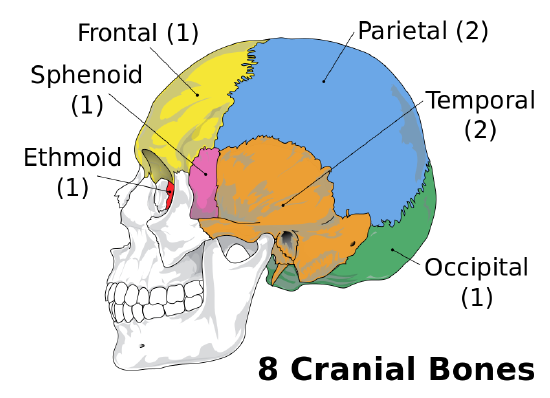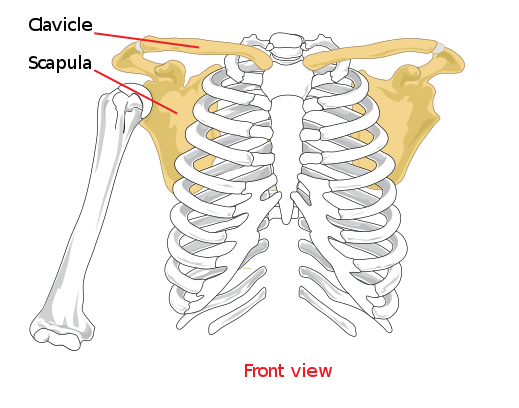14.3: Divisions of the Skeletal System
- Last updated
- Save as PDF
- Page ID
- 22546
Skulls on Display
This somewhat macabre display can be viewed at the Slovak National Museum in Bratislava, Slovakia. The skulls are meant to represent normal human skeletal anatomy. The skull is part of the axial skeleton, which is one of the two major divisions of the human skeleton. The other division is the appendicular skeleton.

Axial Skeleton
The axial skeleton, shown in blue in Figure \(\PageIndex{2}\), consists of a total of 80 bones. Besides the skull, it includes the rib cage and vertebral column. It also includes the three tiny ossicles (hammer, anvil, and stirrup) in the middle ear and the hyoid bone in the throat, to which the tongue and some other soft tissues are attached.

Skull
The skull is the part of the human skeleton that provides a bony framework for the head. It consists of 22 different bones. There are 8 bones in the cranium, which encloses the brain, and 14 bones in the face.
Cranium
The cranium, sometimes called the braincase, forms the entire upper portion of the skull. As shown in Figure \(\PageIndex{3}\), it consists of eight bones: one frontal bone, two parietal bones, two temporal bones, one occipital bone, one sphenoid bone, and one ethmoid bone. The ethmoid bone separates the nasal cavity from the brain. The sphenoid bone is one of several bones, including the frontal bone, that helps form the eye sockets. The other bones of the cranium are large and plate-like. They cover and protect the brain. The bottom of the skull has openings for major blood vessels and nerves. A large opening, called the foramen magnum, allows the spinal cord and brain to connect.

Facial Bones
The 14 facial bones of the skull are located below the frontal bone of the cranium. They are depicted in Figure \(\PageIndex{4}\). Large bones in the face include the upper jawbones, or maxillae (singular, maxilla), which form the middle part of the face and the bottom of the two eye sockets. The maxillae are fused together except for an opening between them for the nose. The lower edge of the maxillae contains sockets for the upper teeth. The lower jaw bone, or mandible, is also large. The top edge of the mandible contains sockets for the lower teeth. The mandible opens and closes to chew food and is controlled by strong muscles. There are two zygomatic or cheekbones and two nasal bones. The nasal region also contains seven smaller bones, as indicated in the figure.

Vertebral Column
The vertebral column, also called the spine or backbone, is the flexible column of vertebrae (singular, vertebra) that connects the trunk with the skull and encloses the spinal cord. It consists of 33 vertebrae that are divided into five regions, as shown in Figure \(\PageIndex{5}\): the cervical, thoracic, lumbar, sacral, and coccygeal regions. From the neck down, the first 24 vertebrae (cervical, thoracic, and lumbar) are individual bones. The five sacral vertebrae are fused together, as are the four coccygeal vertebrae.

The human vertebral column reflects adaptations for upright bipedal locomotion. For example, the vertebral column is less like a rigid column than an S-shaped spring (see a profile view in the figure above). Although newborn infants have a relatively straight spine, the curves develop as the backbone starts taking on its support functions, such as keeping the trunk erect, holding up the head, and helping to anchor the limbs. The S shape of the vertebral column allows it to act as a shock absorber, absorbing much of the jarring of walking and running so the forces are not transmitted directly from the pelvis to the skull. The S shape also helps protect the spine from breaking, which would be more likely with a straight, more rigid vertebral column. In addition, the S shape helps to distribute the weight of the body, and particularly of the internal organs, so the weight load is not all at the bottom, as would occur with a straight spine.
Rib Cage
The rib cage (also called thoracic cage) is aptly named because it forms a sort of cage that holds within it the organs of the upper part of the trunk, including the heart and lungs (Figure \(\PageIndex{6}\)). The rib cage includes the 12 thoracic vertebrae and the breastbone (or sternum) as well as 12 pairs of ribs, which are attached at joints to the vertebrae. The ribs are divided into three groups, called true ribs, false ribs, and floating ribs. The top seven pairs of ribs are true ribs. They are attached by cartilage directly to the sternum. The next three pairs of ribs are false ribs. They are attached by cartilage to the ribs above them, rather than directly to the sternum. The lowest two pairs of ribs are floating ribs. They are attached by cartilage to muscles in the abdominal wall. The attachments of false and floating ribs let the lower part of the rib cage expand to accommodate the internal movements of breathing.

Appendicular Skeleton

The appendicular skeleton, shown in red in Figure \(\PageIndex{7}\), consists of a total of 126 bones. It includes all the bones of the limbs (arms, legs, hands, and feet) as well as the bones of the shoulder (shoulder girdle) and pelvis (pelvic girdle).
Upper Limbs
Each upper limb consists of 30 bones. As shown in Figure \(\PageIndex{8}\), there is one bone, called the humerus, in each of the upper arms, and there are two bones, called the ulna and radius, in each of the lower arms.
The remaining bones of the upper limb are shown in Figure \(\PageIndex{9}\). Each wrist contains eight carpal bones, which are arranged in two rows of four bones each; and each hand contains five metacarpal bones. The bones in the fingers of each hand include 14 phalanges (three in each finger except the thumb, which has two phalanges). The thumb has the unique ability to move into opposition with the palm of the hand and with each of the fingers when they are slightly bent. This allows the hand to handle and manipulate objects such as tools.


Lower Limbs

Each lower limb consists of 30 bones. As shown in Figure \(\PageIndex{10}\), there is one bone, called the femur, in each of the upper legs, and there are two bones, called the tibia and fibula, in each of the lower legs. The knee cap, or patella, is an additional leg bone at the front of each knee, which is the largest joint in the human body.
The remaining bones of the lower limbs are shown in Figure \(\PageIndex{11}\). Each ankle contains seven tarsal bones (including the talus and calcaneus), and each foot contains five metatarsal bones. The tarsals and metatarsals form the ankle, heel, and arch of the foot. They give the foot strength while allowing flexibility. The bones in the toes of each foot consist of 14 phalanges (three in each toe except the big toe, which has two phalanges)


The pectoral girdle (also called shoulder girdle) attaches the upper limbs to the trunk of the body. Its connection with the axial skeleton is by muscles alone. This allows a considerable range of motion in the upper limbs. The shoulder girdle consists of just two pairs of bones, with one of each pair on opposite sides of the body (Figure \(\PageIndex{12}\)). There is a right and left clavicles (collarbone) and right and left scapulae (shoulder blade). The scapula is a pear-shaped flat bone that helps to form the shoulder joint. The clavicle is a long bone that serves as a strut between the shoulder blade and the sternum.
Pelvic Girdle
The pelvic girdle attaches the legs to the trunk of the body and also provides a basin to contain and support the organs of the abdomen. It is connected to the vertebral column of the axial skeleton by ligaments. The pelvic girdle consists of two halves, one half for each leg, but the halves are fused with each other in adults at a joint called the pubic symphysis. Each half of the pelvic girdle includes three bones, as shown in the figure below: the ilium (flaring upper part of the pelvic girdle), pubis (lower front), and ischium (lower back). Each of these bones helps form the acetabulum, which is a depression into which the top of the femur (thigh bone) fits. When the body is in a seated position, it rests on protrusions (called tuberosities) of the two ischial bones.

Review
- What bones are included in the axial skeleton?
- Identify the two main parts of the skull. How many bones does each part contain?
- Describe the vertebral column.
- What are the advantages of an S-shaped vertebral column?
- What is the rib cage, and what is its function?
- What bones are included in the appendicular skeleton?
- How many bones are found in each upper limb? What are they?
- Identify the bones in each of the lower limbs.
- What is the shoulder girdle, and why does it allow considerable upper limb mobility?
- Describe the pelvic girdle and the bones it contains.
- True or False. False ribs are made of cartilage and are not true rib bones.
- True or False. The jaw contains two maxillae and one mandible.
- Describe some of the similarities between the upper limbs and the lower limbs.
- Explain the advantage of having some ribs that are not attached directly to the sternum.
- Put the following vertebral regions in order, from the closest to the head to the farthest from the head:
sacral; lumbar; cervical; coccygeal; thoracic
Explore More
Attributions
- Human skulls on display by KiwiEV, CC0 via Wikimedia Commons
- Axial skeleton diagram by LadyofHats Mariana Ruiz Villarreal, public domain via Wikimedia Commons
- Cranial bones, original by Edoarado, adapted text by Was a bee, CC0 via Wikimedia Commons
- Facial bones, public domain via Wikimedia Commons
- Vertebral column by OpenStax College, CC BY 3.0 via Wikimedia Commons
- Thoracic cage, public domain via Wikimedia Commons
- Appendicular skeleton diagram by LadyofHats Mariana Ruiz Villarreal, public domain via Wikimedia Commons
- Arm bones by BruceBlaus, CC BY 4.0 via Wikimedia Commons
- Bones of the wrist and hand by LadyofHats Mariana Ruiz Villarreal, public domain via Wikimedia Commons
- Leg bones by Jecowa, public domain via Wikimedia Commons
- Foot bones by Blausen.com staff (2014). "Medical gallery of Blausen Medical 2014". WikiJournal of Medicine 1 (2). DOI:10.15347/wjm/2014.010. ISSN 2002-4436. licensed CC BY 3.0 via Wikimedia Commons
- Shoulder bones by LadyofHats Mariana Ruiz Villarreal, public domain via Wikimedia Commons
- Pelvis diagram by Je at uwo, public domain via Wikimedia Commons
- Text adapted from Human Biology by CK-12 licensed CC BY-NC 3.0


